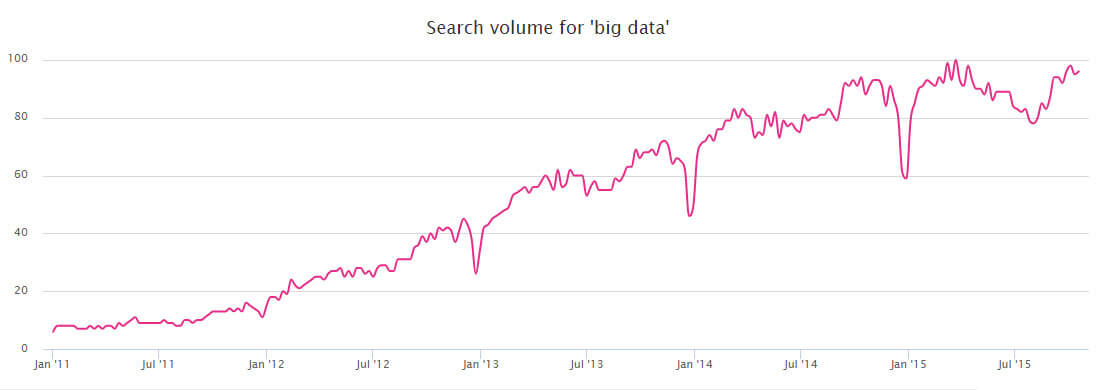Big data is an industry buzzword that’s become an essential part of most marketer’s vocabulary - as you can see from the meteoric rise in search around the term.
The impact for many digital marketers is an increasing focus on analytics, from attribution modelling to social listening, all of which are trying to make our campaigns more effective.
But with so many people advocating the importance of data collection and analysis, it can be tempting to attempt to track and dissect every piece of information your business collects.
 Numbers represent search interest relative to the highest point on the chart. If, at most, 10% of searches for the given region and time frame were for "pizza," we'd consider this 100. This doesn't convey absolute search volume - Google Search Trends
Numbers represent search interest relative to the highest point on the chart. If, at most, 10% of searches for the given region and time frame were for "pizza," we'd consider this 100. This doesn't convey absolute search volume - Google Search Trends
WHAT IS THE SOLUTION?
This is not the route to sure-fire success that it might seem. Who has the time and resources to do this and then implement the findings?
Data and the conclusions you take from it are very important, but not everything is useful in helping you meet your campaign goals. The first step is not to hoard everything, but to work out which pieces of data will actually help you out.
Google Analytics is one of the easiest places to get flooded with superficially useful data that doesn’t have any real takeaways for your business. It’s designed for everyone and inevitably not all businesses need the same information as each other, so the most important first step is to figure out what is and isn’t useful to you.
For a start, there’s some basics to begin with to ensure the data you have isn’t being skewed. Be sure to set up a filter that blocks any internal or client traffic as this is useless, meanwhile be sure to consider what location data is being analysed.
If you only serve people in the UK, is it really useful to know how long Americans spend on your site? All you’ll do is make your stats look worse than they are or try and cater for visitors who will never become customers.
It’s also essential to know what you want individual pages to do. It’s often assumed that a high bounce rate is a sign that a page is failing, but this really depends on what people are doing.
If page layout is tweaked to make contact details more obvious, bounce rates might rise along with conversions, as customers find the information they need rapidly and proceed to call or email.
Without having the right details and context around the bounce rate, it could be very misleading. In this case, having call tracking installed on your site would mean that you could see when having a high bounce rate is actually a sign of success.
There are similar lessons to be learnt when it comes to social media analytics as well, particularly with ads. Each platform usually offers its own analytics service so you can see how well your ads are doing. Of course their ultimate aim is to get you to spend more money, so you should always be slightly wary of the information you’re given and what it’s actually saying.
A prime example of this might be the engagement rate of a promoted tweet, which indicates how many people are interacting with it. At first, it seems self-evident that a high engagement rate is straight forwardly positive, but you need to look deeper at what it’s actually telling you.
An ‘engagement’ can be a click on a link in a tweet, retweeting, a favourite, a click on a hashtag, expanding the tweet, following or replying to you. Some of these actions, like clicking on a link or retweeting, clearly have a higher value to you than expanding on a tweet.
A 35% engagement rate may sound good, but it could be a misleading sign of success if most of these actions aren’t what you need to see to hit your social media goals. Data is incredibly powerful – but part of harnessing this is selecting what to track.
In the end, are the gains you’re making from your analysis worth the time you spend on them? If not, you know what to do.